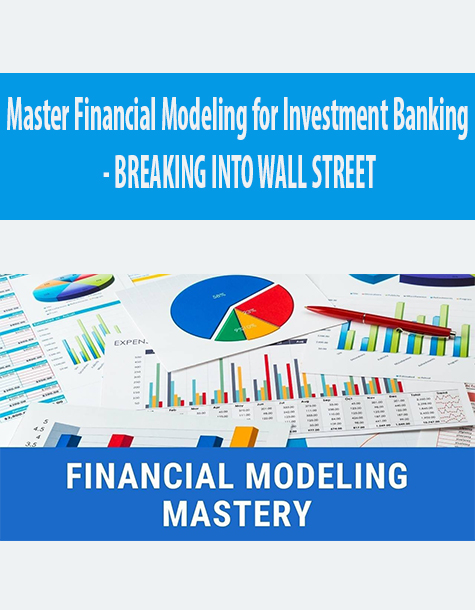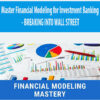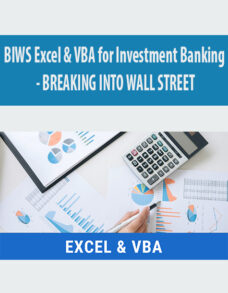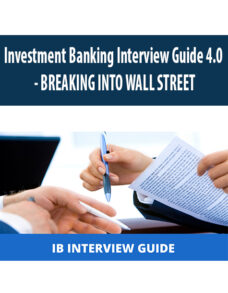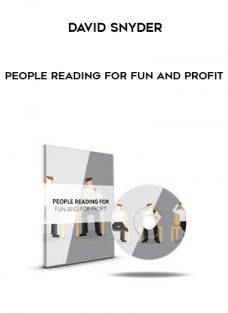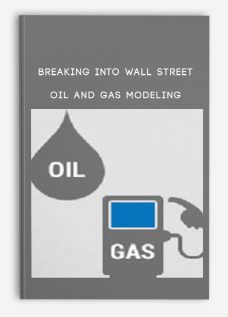Master Financial Modeling for Investment Banking – BREAKING INTO WALL STREET
Original price was: $397.00.$109.00Current price is: $109.00.
File size: 30.3 GB
Media Type: Online Course
Delivery Time: 1-12 hours.
Content proof: Watch here!
- Description
Description
Master Financial Modeling for Investment Banking – BREAKING INTO WALL STREET – Instant Download!
“Here’s How to Master Accounting, Valuation, and Financial Modeling So You Can Dominate Your Investment Banking Interviews and Succeed On The Job”
Introducing the course that members are calling ‘Deal Experience in a Box’… The Breaking Into Wall Street Financial Modeling Mastery Course is so close to the “real thing” it’s uncanny.
No other investment banking or financial modeling course on the market today – at ANY price – arms you with the same conceptual and practical expertise.
You’ll quickly gain ‘virtual deal experience’ with 10+ comprehensive, real-life investment banking, private equity, and hedge fund case studies from around the globe so you can beat out other candidates in interviews and rapidly move up the ladder.
- Ensure Your Competitive Edge in Today’s Market. Get dozens of video tutorials, notes for each lesson, transcripts, and 15+ in-depth, practical case studies from around the globe. Achieve the deep conceptual understanding that bankers are looking for, but rarely find – and discover how to use financial modeling to outperform your peers on the job.
- Dominate Your Interviews. The Financial Modeling Mastery lessons take you from A to Z in accounting, valuation, and financial modeling – and you’ll get to test your knowledge by completing practice exercises and written case study questions at the end of each module.
- Prepare for IB, PE, and HF Case Studies. Everything in the course is based on case studies of real companies – including firms in North America, Europe, Asia, and Australia – to ensure you gain a truly global perspective. You’ll know exactly what interviewers are looking for in case studies, and you’ll learn how to set up your models and answer questions successfully.
- Learn by Watching with Video-Based Training. Video learning is more engaging, and there’s no substitute for watching over the shoulder of an IB veteran as they work through real-world Excel models. But it’s also helpful to have the written version, so you’ll get notes in the Excel files for each lesson, along with detailed written guides and the full, word-for-word transcripts.
- Learn Accounting, Valuation, and Merger and LBO Models. These are the fundamental skills you’ll need in investment banking, private equity, and hedge funds – and you’ll be ahead of the game by mastering them before you start working.
- Complete Practice Exercises. You’ll get “Before” and “After” Excel files for each lesson – follow along with the lesson, complete the exercises, and then check your answers afterward. You can use these exercises to learn, measure your progress, and review the material quickly whenever you need it.
- Test Yourself with Quiz Questions. Hundreds of quiz questions test your knowledge, guarantee your engagement, and support quicker mastery of the concepts. You’ll also get full answer keys and explanations for all these practice questions.
- Track Your Progress and Take Notes. You can check off each lesson as you move through the material and take notes throughout. It’s easy to return and refresh your knowledge whenever you need to do so. Plus, you can create Playlists of the key lessons you need to watch and review.
What You Get – And What the BIWS Financial Modeling
Mastery Course Will Do for You…
When you’re interviewing for internships and full-time positions at investment banks, you’ll always get a few questions over and over…
- How much do you know about accounting?
- Can you walk me through a valuation?
- What happens in a merger model or LBO model when you adjust the assumptions…
- How would you describe your financial modeling skills?
When you master real-world techniques and case studies, you have a significantly better chance of landing prime jobs and internships with the top investment banks, private equity firms, and hedge funds.
The Financial Modeling Mastery course helps you gain all that real-world knowledge via video-based training created by investment bankers.
You’ll get a total of 308 videos – everything you need to beat the competition in interviews and get a head start before you start working. You’ll also get detailed written guides and word-for-word transcripts to make it easier to scan and review the topics.
MUCH MORE THAN THEORY
We base everything in the Financial Modeling Mastery course on what investment bankers and other finance professionals actually do in real life:
- To gain the proper background, you’ll start by learning key accounting and finance concepts with examples based on real companies, such as Target and Best Buy; you’ll learn how the financial statements link together and how you can analyze them with key metrics and ratios.
- Then, you’ll move into the “global case studies,” which include companies such as Toro (U.S.), Atlassian (Australia), EasyJet (U.K.), Vivendi (France), Steel Dynamics (U.S.), Jazz Pharmaceuticals (U.S.), Builders FirstSource / BMC Stock Holdings (U.S.), SunPower / Maxeon (U.S. and Singapore), Fortum / Uniper (Finland and Germany), NichiiGakkan (Japan), Great Canadian Gaming Corporation (Canada), Viridor (U.K.), Cars.com (U.S.), Kakao / Daum (Korea), and Netflix (U.S.).
- In each case study, you’ll analyze a company or deal, build a model, and then make an investment recommendation or recommend the proper price and deal structure – and you’ll answer written questions about each one. This is the type of work you do all day in investment banking, private equity, and hedge funds.
Through these case studies, you’ll discover how to:
- Build 3-statement projection models and answer accounting questions in interviews.
- Understand Equity Value and Enterprise Value at a deep level – way beyond whatever the paid monkey army on Investopedia or Wikipedia says about these concepts!
- Value a company – including how to find public comps and precedent transaction, how to build a DCF model, and how to use the valuation output in a stock pitch, a pitch book, and an equity research report.
Create merger models – including how to combine and adjust the financial statements, evaluate accretion/dilution
and other metrics, and how to use the model to advise clients on their best options.
Build LBO models, from the transaction assumptions to the debt schedules, financial projections, cash flows, and calculations of the IRR and money-on-money multiples – and the investment recommendation at the end.
The information you’ll find is so detailed and so thorough that our customers regularly come from top-ranked universities, investment banks, and business schools.
Take a Look
Module 1: Modeling Overview and Core Concepts
In this introductory module, you’ll learn what “financial modeling” means, how you use it in real life, and the core concepts required to understand the rest of this course, including the time value of money, Present Value and Net Present Value, the Discount Rate, and the Internal Rate of Return (IRR).
Module 2: Accounting Concepts, the Financial Statements, and Interview Questions
We’ll explore accounting from a business perspective, and we’ll drill down using examples of our online business to teach you how and why the financial statements work the way they do. You’ll also learn how to answer common interview questions, including both single-step and multi-step scenarios, and how more advanced items, such as Operating Leases, Net Operating Losses, and Deferred Taxes, work.
Module 3: More Advanced Accounting
You’ll learn about the Book Value, Face Value, and Market Value of Debt here, as well as Issuance Fees and Original Issue Discount (OID); other topics include Equity Investments and Noncontrolling Interests, the tax treatment of Stock-Based Compensation, Unrealized Gains and Losses, FIFO vs. LIFO for Inventory, and Pension Accounting for defined-benefit pension plans.
Module 4: Projecting the 3 Statements (Toro and Atlassian)
In this module, you’ll complete 60-minute and 2-hour case studies based on 3-statement projection models for Toro, a landscape maintenance equipment company, and Atlassian, a subscription-based enterprise software company, and you’ll make investment recommendations based on the output of both exercises.
Module 5: More Advanced 3-Statement Projections (EasyJet)
In this module, you’ll complete a 3-hour 3-statement modeling test for EasyJet, a low-cost carrier based in the U.K., with routes all over Europe. You will then use the output of this model to advise the company on its proper mix of Debt and Equity. You will build revenue and expense projections based on drivers such as ASKs, Load Factors, and Passenger Yields, and you’ll add a Debt & Equity Schedule to the model to support the company’s financing needs.
Module 6: Equity Value, Enterprise Value, and Multiples (Target, Vivendi, and Zendesk)
In this module, you’ll learn how to calculate Equity Value, Enterprise Value, and Valuation Multiples for companies that follow U.S. GAAP and IFRS, as well as the core concepts everything – including how items like Equity Investments, Noncontrolling Interests, Pensions, Leases, and Net Operating Losses factor into the calculations.
Module 7: Valuation and DCF Case Study (Steel Dynamics)
In this module, you’ll complete a 2-hour valuation and DCF case study based on Steel Dynamics, a leading steel manufacturing company in the U.S., and you’ll learn how to project Free Cash Flow, calculate the Discount Rate, estimate Terminal Value, and use Public Comps and Precedent Transactions.
Module 8: More Advanced Valuation and DCF Case Study (Jazz Pharmaceuticals)
In this module, you’ll complete a 1-week “take home” valuation and DCF case study based on Jazz Pharmaceuticals, a specialty pharmaceutical company based in the U.S. that develops orphan drugs. You’ll project revenue for its existing and pipeline drugs, add stub periods and the mid-year convention to the DCF, and complete Public Comps and Precedent Transactions using corporate filings.
Module 9: Valuation Interpretation and Real-Life Usage (Jazz Pharmaceuticals)
In this module, you’ll learn how to apply and interpret a valuation in real life by creating a short stock pitch (for hedge fund and asset management roles), equity research report, and investment banking pitch book for Jazz Pharmaceuticals based on the valuation and DCF analysis from the previous module.
Module 10: M&A Concepts and Full Merger Model (Builders FirstSource and BMC Stock Holdings)
In this case study, you’ll analyze Builders FirstSource’s $2.5 billion acquisition of BMC Stock Holdings and complete both 60-minute and 3-hour versions of the model. You’ll also learn about fundamental M&A concepts in the first few lessons, such as deal types, payment methods, public vs. private company assumptions, and Equity Value and Enterprise Value in M&A. The last few lessons of the more advanced case study cover M&A valuation, contribution analysis, and value creation analysis.
Module 11: More Advanced Merger Models (Multiple Case Studies)
You’ll complete a more advanced version of the Builders FirstSource / BMC model here, including quarterly projections and stock vs. asset vs. 338(h)(10) treatment, and you’ll complete additional case studies on SunPower’s spinoff of Maxeon and a Sum-of-the-Parts valuation for the deal and Fortum’s acquisition of a majority stake in Uniper (including variable close dates and stub-period financial statements). Each case study includes a presentation or questions and answers at the end.
Module 12: Leveraged Buyouts and LBO Models (Multiple Case Studies)
You’ll complete multiple case studies in this module, ranging from a simple LBO model to a paper LBO model to 60-minute, 90-minute, and 3-hour modeling tests based on a variety of companies and deals (including a private company in Germany, Bain’s leveraged buyout of nursing-home operator NichiiGakkan in Japan, and Apollo’s buyout of the Great Canadian Gaming Corporation). You’ll learn how to build models quickly and efficiently, answer case study questions, and complete modeling tests starting from scratch and starting from templates.
Module 13: More Advanced LBO Models (Viridor and Cars.com)
You will build a more advanced LBO model based on KKR’s buyout of Viridor (divestiture from Pennon Group) in the U.K., with features such as stub periods, a dividend recap, and management earn-outs; you’ll also make investment recommendations to both the equity investors and the lenders. The second case study is an open-ended “take home” one based on Cars.com, in which you complete industry research, build your own model, and make an investment recommendation at the end.
Module 14: Private Companies, IPOs, and Reverse Mergers (Kakao / Daum)
In this case study, you will learn all about private company valuation and financial modeling via Kakao’s reverse merger with Daum Communications (two Internet/mobile companies in South Korea). You’ll learn how to make adjustments for private companies, how to model an initial public offering (IPO), and how to advise the company on a reverse merger vs. traditional M&A deal vs. IPO.
Module 15: Debt, Equity & Convertibles (Netflix)
In this case study, you’ll advise Netflix on the best way to secure the $1.5 billion it needs to fund its international expansion efforts. You’ll build a 3-statement model for the company with multiple scenarios, analyze its credit stats and ratios and covenants, and analyze bond yields, duration, convexity, call and put options, make-whole calls, refinancing options, and more. You’ll also value a possible convertible bond, analyze its payoff profile and dilution, create a follow-on equity proceeds analysis, and draft a credit memo and longer advisory presentation for the company.
Our Customers Love Breaking Into Wall Street
At last count, over 48,569+ students, entry-level professionals and career changers have used Breaking Into Wall Street to master financial modeling, win interviews, and break into high-paying jobs in investment banking, private equity, hedge funds, equity research, and more.
Take a look at what some of them have to say (these are actual unedited email screenshots… a few details have been blacked out to protect customers’ privacy.)
“Great news, I just got a full-time offer in IB J.P. Morgan in London!! Your courses have been absolutely key in achieving this.”

Master Financial Modeling for Investment Banking – BREAKING INTO WALL STREET, what is it included (Content proof: Watch here!)
- Module 0 – Financial Modeling Study Plans and Quick Reference Guides
- Module 1 – Financial Modeling Overview and Core Concepts
- Module 2 – Accounting Concepts, the Financial Statements, and Interview Questions
- Module 3 – More Advanced Accounting
- Module 4 – 60-Minute and 2-Hour 3-Statement Modeling Case Studies (Toro and Atlassian)
- Module 5 – 3-Hour 3-Statement Modeling Test and Debt vs. Equity Case Study (EasyJet)
- Module 6 – Equity Value, Enterprise Value, and Valuation Multiples
- Module 7 – 3-Hour Valuation and DCF Case Study from Blank Sheet
- Module 8 – 1-Week, Open-Ended Valuation and DCF Case Study
- Module 9 – Valuation Interpretation, Real-Life Usage, and Supplemental Methodologies
- Module 10 – M&A Concepts and Full Merger Model
- Module 11 – More Advanced M&A Deals and Merger Models
- Module 12 – Leveraged Buyout Concepts and Simpler LBO Models
- Module 13 – More Complex LBO Models and Case Studies
- Module 14 – Private Companies, IPOs, and Reverse Mergers
- Module 14 – Private Company, Venture Capital, and SaaS Modeling and Valuation
- Module 15 – Debt, Equity & Convertibles
- Module 16 – Certification Quiz

